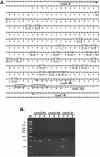The complete nucleotide sequence and RNA editing content of the mitochondrial genome of rapeseed (Brassica napus L.): comparative analysis of the mitochondrial genomes of rapeseed and Arabidopsis thaliana
- PMID: 14530439
- PMCID: PMC219474
- DOI: 10.1093/nar/gkg795
The complete nucleotide sequence and RNA editing content of the mitochondrial genome of rapeseed (Brassica napus L.): comparative analysis of the mitochondrial genomes of rapeseed and Arabidopsis thaliana
Abstract
The entire mitochondrial genome of rapeseed (Brassica napus L.) was sequenced and compared with that of Arabidopsis thaliana. The 221 853 bp genome contains 34 protein-coding genes, three rRNA genes and 17 tRNA genes. This gene content is almost identical to that of Arabidopsis: However the rps14 gene, which is a pseudo-gene in Arabidopsis, is intact in rapeseed. On the other hand, five tRNA genes are missing in rapeseed compared to Arabidopsis, although the set of mitochondrially encoded tRNA species is identical in the two Cruciferae. RNA editing events were systematically investigated on the basis of the sequence of the rapeseed mitochondrial genome. A total of 427 C to U conversions were identified in ORFs, which is nearly identical to the number in Arabidopsis (441 sites). The gene sequences and intron structures are mostly conserved (more than 99% similarity for protein-coding regions); however, only 358 editing sites (83% of total editings) are shared by rapeseed and Arabidopsis: Non-coding regions are mostly divergent between the two plants. One-third (about 78.7 kb) and two-thirds (about 223.8 kb) of the rapeseed and Arabidopsis mitochondrial genomes, respectively, cannot be aligned with each other and most of these regions do not show any homology to sequences registered in the DNA databases. The results of the comparative analysis between the rapeseed and Arabidopsis mitochondrial genomes suggest that higher plant mitochondria are extremely conservative with respect to coding sequences and somewhat conservative with respect to RNA editing, but that non-coding parts of plant mitochondrial DNA are extraordinarily dynamic with respect to structural changes, sequence acquisition and/or sequence loss.
Figures



References
-
- Palmer J.D. and Herbon,L.A. (1987) Unicircular structure of the Brassica hirta mitochondrial genome. Curr. Genet., 11, 565–570. - PubMed
-
- Ward B.L., Anderson,R.S. and Bendich,A.J. (1981) The mitochondrial genome is large and variable in a family of plants (Cucurbitaceae). Cell, 25, 793–803. - PubMed
-
- Unseld M., Marienfeld,J.R., Brandt,P. and Brennicke,A. (1997) The mitochondrial genome of Arabidopsis thaliana contains 57 genes in 366,924 nucleotides. Nature Genet., 15, 57–61. - PubMed
-
- Notsu Y., Masood,S., Nishikawa,T., Kubo,N., Akiduki,G., Nakazono,M., Hirai,A. and Kadowaki,K. (2002) The complete sequence of the rice (Oryza sativa L.) mitochondrial genome: frequent DNA sequence acquisition and loss during the evolution of flowering plants. Mol. Genet. Genomics, 268, 434–445. - PubMed
Publication types
MeSH terms
Substances
Associated data
- Actions
LinkOut - more resources
Full Text Sources
Other Literature Sources
Molecular Biology Databases

